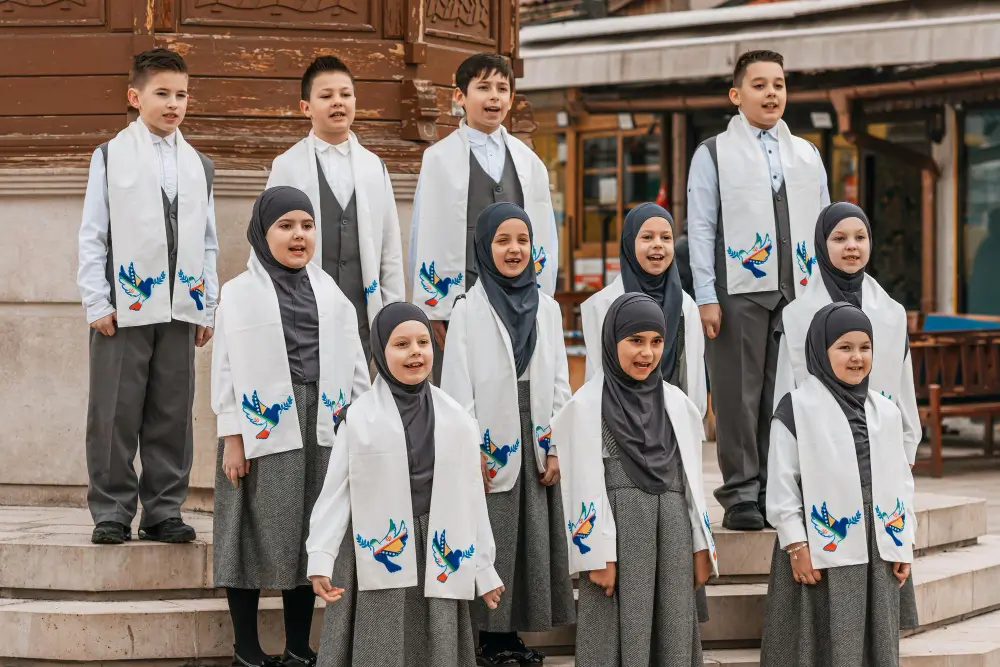It is no wonder if education becomes the focus area while focusing on sustainability because the whole world is turning towards it. One of the most important areas from which we can make significant contributions is through the materials used in the education uniform. Traditional school uniforms are mostly made of synthetic fibers that are the least eco-friendly, yet with the rise of sustainable fabrics, the future of uniforms has turned brighter and greener.
Let’s dive into why sustainable uniforms made from eco-friendly fabrics are a step in the right direction for both our children’s health and the planet’s future.
The Need for Change

Traditional education uniforms have large environmental impacts, mostly those made from synthetic materials, mainly polyester-based materials. These fabrics are derived from non-renewable resources and are not biodegradable. After many years of usage, these uniforms tend to tear or find their way to the landfills as part of pollutant contributions.
But then, a shift is taking place. There are schools, manufacturers, and parents who are waking up to the wonderful benefits of sustainable fabrics for uniforms. For if we would use environmentally-friendly materials, we would reduce our carbon footprint, save resources and conserve, and help protect the environment, never giving it to a future generation.
What Makes a Fabric “Eco-Friendly”?
Eco-friendly fabrics are made from renewable, natural, or recycled materials. Eco-friendly fabrics have a much lesser environmental impact in comparison to conventional fabrics. Some of the examples of sustainable fabrics that are starting to make their way into uniforms include:
1. Organic Cotton
Organic cotton is grown without the application of pesticides or fertilizers, thus providing for a healthier environment and safer wear for persons wearing it. It’s soft and breathable, durable, and performs well in school uniforms, besides requiring less water in growing than other cotton.
2. Recycled Polyester
Recycled polyester, made from post-consumer waste, such as plastic bottles or discarded garments, is melted down and spun into fibers. This process reduces waste and the need for virgin materials and is more sustainable for school uniforms.
3. Tencel (Lyocell
Tencel is a fiber based on wood pulp from sustainably harvested sources; it is often eucalyptus. The process requires significantly less water and energy than traditional textiles, and Tencel is biodegradable, so it won’t sit in a landfill for years as synthetic fibers do.
4. Hemp
Hemp is very sustainable because it grows easily without using any pesticides and a minimal amount of water. It’s strong, breathable, and resistant to mold and mildew, ensuring longer-lasting school uniforms.
5. Bamboo Fabric
Another eco-friendly fabric is bamboo, which is rapidly gaining popularity. It grows rapidly, uses very little water, and doesn’t need any pesticides at all. Bamboo fabrics are soft, moisture wicking, and biodegradable, ideal for children’s uniforms.
Advantages of Green Education Uniforms

1. It will contribute to a lesser environmental impact
We reduce the demand for non-renewable resources, cut down on pollution, and reduce the amount of waste that lands up in landfills by switching to sustainable fabrics. It is a small change that, when adopted at scale, can make a big difference in the environment.
2. Better for Children’s Health
Sustainable fabrics like organic cotton are often free from harsh chemicals and dyes, making them safer for children’s sensitive skin. Parents can feel confident knowing that their kids are wearing clothing that’s gentle and non-toxic.
3. Long-Lasting Durability
Eco-friendly fabrics such as organic cotton, hemp, and bamboo tend to last longer than synthetic ones. Uniforms from schools made from these materials tend to withstand the daily/regular life of schools. Therefore, they would be more effective to last longer rather than needing frequent replacement.
4. Comfort and Breathability
Many sustainable fabrics, such as organic cotton and bamboo, are naturally breathable and moisture-wicking. This means that the kids would stay cooler for a more comfortable school day, even in hot climates such as those found in Dubai.
5. Supporting ethical practices
Many of these eco-friendly fabrics are actually made in factories that have clear fair labor practices wherein workers are treated fairly with fair compensation. By choosing sustainable education uniforms, parents and schools can help support fair fashion practices and ensure that all members of the supply chain are valued.
Making the Switch to Sustainable Uniforms

What could be considered a significant undertaking is actually rather easy: switching to sustainable uniforms. Many uniform manufacturers now offer options for eco-friendly development, so it’s merely a question of deciding which materials best fit the needs of your school.
- For the Parents : Look for uniform brands that advertise eco-friendly fabrics like organic cotton, recycled polyester, or Tencel. They’re just as reasonably priced as the more traditional uniforms but offer the added benefit of being kinder to the planet.
- Schools: Work with suppliers to adopt sustainable fabrics. You may also implement a uniform recycling program, where students can hand down lightly used uniforms to other pupils; the lifespan of the uniform is extended while ensuring waste is minimized for a circular economy.
For Producers: A sustainable product will benefit them in the long run by not bringing pollution into the body of the consumer, giving comfort to customers, who have potential and thriving demand for such products.
Conclusion
The day is becoming greener for education uniforms. Eco-friendly fabrics like organic cotton, recycled polyester, Tencel, and hemp can make a significant difference in the environment and our children’s health. Whether you’re a parent, educator, or manufacturer, making the switch to sustainable education uniforms is a simple and effective way to contribute to a more sustainable future. It’s time to say goodbye to traditional, harmful materials and welcome a new era of eco-friendly, comfortable, and durable school uniforms. Let’s take the first step towards a greener tomorrow,one uniform at a time. To change the new pattern, AttireCorp has edged its way into the market with a sense of quality production in relation to the use of renewable materials to create education uniforms for those interested in making a change.

